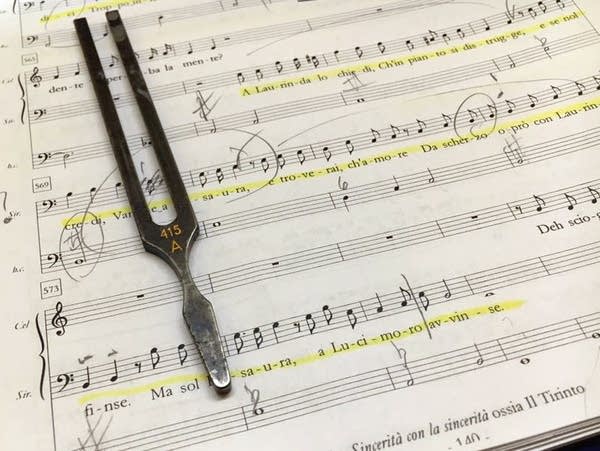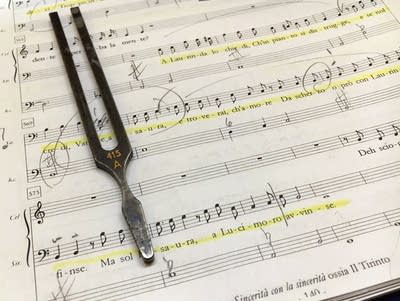15 years ago Garrick Comeaux, an American musician living in Italy, was scrabbling around in the extensive archive of the Estense Library in Modena, looking for the score of Santa Agnese, an oratorio by the Italian baroque composer Bernardo Pasquini.
He found it, and went on to make an acclaimed recording of the piece with his Rome-based early music ensemble Consortium Carissimi.
Comeaux found something else that day in the Estense catalogue: the manuscript copy of an opera he never knew existed, also by Pasquini, entitled Il Tirinto.
Opening it, he was immediately excited, recognizing that he had "stumbled into a jewel of the 17th century," unperformed in over three centuries. The manuscript was, Comeaux recalls, "in great shape," and it was a relatively simple, if time-consuming, task to make a copy of the music for future reference.
Transcribing Il Tirinto rapidly convinced Comeaux of the opera's artistic merits, and made him itch to stage it. A few years later, though, Comeaux returned to Minnesota, and the possibility of resurrecting Il Tirinto for a contemporary audience receded.
Until now, that is: this weekend Pasquini's opera rides again, in a fully staged production run of three performances at the Ritz Theater in Northeast Minneapolis.
It is, according to the Italian music scholar Arnaldo Morelli, a significant moment, "a milestone in recovering Italian music of the 17th century," and "the first time in modern times that an opera of Bernardo Pasquini comes to life."
Il Tirinto is much more than a museum piece, however, according to Alessandro Quarta, the Italian conductor who will lead the Minneapolis performances. "The music is extremely clean, fresh, the themes are so catchy and natural," he says.
"Pasquini belongs to the generation of Corelli, Stradella, Alessandro Scarlatti, a little before Vivaldi. But he was the eldest of this generation, and he taught something to every one of them. So he's really, really important."
Garrick Comeaux agrees. Il Tirinto will, he says, appeal to an audience far broader than the small coterie of historians and academics who automatically welcome any new discovery or disinterment.
"It struck me as an incredibly transparent piece of music," he says. "It was always in my back pocket, although I didn't have the opportunity to get it off the ground in Italy. Consortium Carissimi is celebrating its tenth season in Minnesota next year, so it's kind of nice that we have now brought this opera on stage."
For Alessandro Quarta, a specialist in Pasquini's music, it is a first visit to Minnesota, and a first encounter with the team of locally based singers cast by Comeaux for the new production.
Among these is a core of Consortium Carissimi regulars, solidly grounded in the specialized techniques of baroque vocal music and early music interpretation. (The performers include Classical MPR host Steve Staruch.)
While technical know-how is important, Quarta also identifies in Comeaux's singers "a different, fresh, beautiful feeling in approaching this repertoire that I really love. Working with this cast is a really fantastic experience."
Il Tirinto will also, Quarta promises, be "very user-friendly, and very funny." The basic storyline — two fathers trying to marry off their uncooperative daughters — develops a Shakespearian comic intricacy, delightfully counterpointed in Pasquini's sparkling, quick-witted music.
The job of bringing the comedy alive on stage has been entrusted to Jon Cranney, a veteran in Twin Cities theatrical circles. "He's doing an incredible job," Comeaux enthuses. "He's found the right costumes, he's got the sets, the lights, he's got the whole thing under his belt."
Comeaux's attention to detail extends to the orchestra accompanying the singers on the evening. A pair of harpsichords, a baroque harp, archlute, viola da gamba, sixteen-foot bass, sackbut, and two violins will work in various combinations, allowing a historically accurate recreation of the sound-world Pasquini himself might have expected.
The fact that the score of Il Tirinto, like most manuscripts of the period, has few indications of which instruments should be used when, is for Garrick Comeaux an added source of excitement in the preparation process.
"There's an incredible freedom to choose which instruments you want," he explains. "That's something that Alessandro is always choosing during rehearsals, for the colors to be specific to what's happening on stage. It's very creative."
That sense of fresh discovery, of detective work becoming living theater, is part of what drives Comeaux forward, to put on stage a work which might otherwise have been permanently lost to music history.
That, and the thrill of allowing audiences to delve further back than usual in the operatic story — before Handel, Gluck and Mozart happened — to the form's origins in the works of Monteverdi and his contemporaries.
"This is where it all started," Comeaux says. "It's going to be a delightful evening. Come expecting a big surprise, because it will be a surprise. You have no idea until you've seen it how much fun you're going to have."
Terry Blain was educated in Northern Ireland and Cambridge, England, and writes for a wide range of publications, including BBC Music Magazine and Opera Magazine. In his spare time he is an avid record collector, and walks his dog Buddy.
Love the music?
Show your support by making a gift to YourClassical.
Each day, we’re here for you with thoughtful streams that set the tone for your day – not to mention the stories and programs that inspire you to new discovery and help you explore the music you love.
YourClassical is available for free, because we are listener-supported public media. Take a moment to make your gift today.

